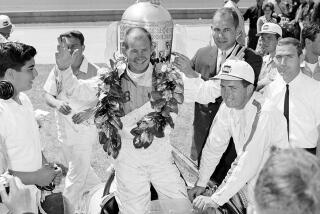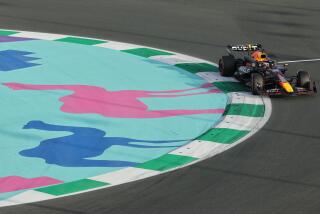Track Record of a Driven Man
- Share via
Carroll Shelby and Phil Hill stand proudly on the podium at Sebring. Shelby’s recently broken arm is in a cast and rigged so he could help drive the Ferrari 750 Monza they have just raced to victory at the storied South Florida track.
Or so they think. As it turns out, Phil Walters and Mike Hawthorne, in a Jaguar D-Type owned by Briggs Cunningham, have been declared the winners.
When race officials go back through the timing and scoring to confirm the results, Shelby and Hill are left with second place.
It is 1955, and adversity has dealt Shelby another setback. Bad enough to race with a shattered elbow--a souvenir of a racing accident four months earlier--but to watch the trophy go to someone else. . . .
For Shelby, now 78, that memory is one of the few that doesn’t involve his taking the checkered flag. It is, however, one of many instances in which he came from behind, and if not winning outright, achieved more than expected by anyone--except perhaps for Shelby himself.
“I’ve always done what I wanted,” he said in a recent interview. “I’ve been very fortunate.”
That plain talk may reflect his humble beginnings in Texas as a chicken farmer and oil-field roughneck turned amateur racer. But Shelby can look back today at nearly half a century at the forefront of the American performance-car scene.
The man’s story is by now the stuff of legend, chronicled in books, on Web sites and in a History Channel special next week. His life includes chapters as a racer, until heart problems forced him from the track in the early 1960s; as a builder and team owner who led the American invasion of European racing later in that decade; and as the creator of a series of famed specialty cars for Ford, Dodge and his own Shelby American Inc.
Today, he divides his time between Las Vegas and Los Angeles, overseeing his car businesses, collaborating on a promising compact internal-combustion engine and devoting time to the Carroll Shelby Children’s Foundation, which assists indigent children who suffer heart or kidney problems. (When Shelby underwent a long-overdue heart transplant in 1990, the donor was, fittingly enough, a 38-year-old Vegas gambler.)
Shelby’s latest car, the limited-edition Series 1, is a labor of love that started nearly eight years ago.
He didn’t like the first two prototypes. Furthermore, the Oldsmobile engine he was buying from General Motors was putting out only 320 horsepower instead of the expected 375 ponies (a bone of contention with which Olds disagrees, having told Autoweek magazine that certifying output was up to Delphi, then GM’s technical and parts division). There were financial problems, eventually solved by a partnership with body-parts builder Venture Industries of Las Vegas, and quality-control issues that vexed auto reviewers who had the chance to test-drive pre-production models (and then scorched it in early reviews).
With all that sorted out, Shelby American has delivered more than 200 of the first 230 Series 1 cars sold in the last three years.
“We are overcoming our problems,” Shelby said, “but with any little company, problems are magnified.
“It’s easy to build a car, but development is hard. When a small company has to spend $3 million to $4 million to build prototypes for crash testing, that makes it hard.
“I bet I get 50 calls a year from someone who wants to build a car. But it’s practically impossible for a small company. A lot of them came in because the economy was good, but they’ll be dropping like flies now.”
In addition to the Series 1, Shelby American builds exact replicas--what it calls “continuation cars”--of the Ford-powered 289 and 427 S/C Shelby Cobras that took on Ferrari in the ‘60s.
It’s an important part of the business--and to Shelby a part of his legacy that he will protect at all costs. Indeed, the company has taken legal action to try to stop others from making copies of the Cobra roadsters and the Daytona Coupe, of which six were built to compete with Ferrari and with which Shelby won the world constructor’s title in 1965. (See accompanying story.)
*
Shelby took risks on and off the racetrack, and often came away the winner. But it wasn’t all luck.
Art Evans, author of “The Fabulous Fifties: A Decade of Sports Car Racing in Southern California” (Photo Data Research, 2001), recalls Shelby’s shrewd business sense when the Texan was still driving race cars.
“Carroll was very successful, but he was in ‘amateur’ sports car racing. After Rodger Ward won his first [U.S. Auto Club] championship in 1958, Ward told Carroll, ‘You’re a pretty good country driver. You should turn pro and race at Indianapolis.’ Shelby asked what kind of money he could make, and when Ward told him, Shelby replied: ‘I couldn’t afford that.’ ”
Despite his amateur status, he was getting more money from his sponsors than he would as a pro.
After health problems ended his driving career, Shelby turned his sights toward building cars. In late 1961, AC Cars of England lost its engine supplier. He proposed that the company continue to build the chassis for a Shelby sports car to be powered by an American V-8.
Shelby says he was inspired to build the car because of Sydney Allard’s success--Allard’s London-built sports car chassis married to a Cadillac engine was competitive in the 1950s--and because the British sports cars came over with 75-horsepower engines in the same space that would take a 300-horse unit.
With Ford Motor signed up to supply a new small V-8, horsepower would be no problem. AC agreed to ship chassis, and the name “Cobra” came to Shelby in a dream.
Production of the first Cobras went slowly, as the crew at Shelby American’s shop in Venice on L.A.’s Westside dealt with extensive re-engineering of the chassis. Shelby had only two completed cars by mid-1962.
To make it seem as though more cars existed, his crew repainted one of the cars a different color for each of its magazine test drives. It was a different time, and Shelby had to be creative.
Allen Grant, who worked as a mechanic and driver, recalls being hired as a welder for $2.50 an hour with the offer that if Shelby needed a driver, Grant would get a chance. After about a week in the shop, he found out he wasn’t the only person in that position.
“He used that bait with a whole bunch of guys,” Grant said at a Shelby American employee reunion last spring.
Grant likes to tell of a friend who would hang around the shop and help the crew at races. One day, Shelby looked out the window of his office to see a young man sitting in one of the Cobras, making his own engine noises. When Shelby asked who it was, someone said, “That’s George Lucas; he’s a friend of Allen Grant.” The kid making car noises went on to make one of the quintessential car films, “American Graffiti.”
Racing standout Dan Gurney, who won respect for American drivers and constructors piloting Shelby’s and Ford’s racing cars, draws parallels between his longtime friend and another bigger-than-life Texan, Lyndon B. Johnson.
“Carroll came out of the same mold,” Gurney said. “If he was on your side and he was speaking for your team, we felt we’d win most of the negotiations. He was very charismatic.”
“It was really fun to be part of this group--all Yanks, mostly from Southern California,” Gurney said, and to succeed in Europe “with your own countrymen was a very special thing.”
*
Just last month, Shelby’s service to Ford and its motor-sports operation was recognized when Edsel Ford II, a great-grandson of the company’s founder, handed him the Spirit of Ford Award at a dinner in Pebble Beach, Calif.
The award, instituted in 1988, is given for “significant contributions to motor sports,” Ford said, remarking that Shelby’s was presented to him on the 100th anniversary of Ford Motor’s participation in auto racing.
Shelby led Ford to its first big international racing victory at Le Mans in France in 1966--a race in which Ford-powered cars, two of them wearing Team Shelby colors, took all three top positions. He also developed, in addition to the Ford-powered Cobra sports cars, a series of Shelby Mustangs for the auto maker in the mid-1960s.
Shelby said the Le Mans victories stand out in his career because American entries rarely win the European-dominated 24-hour endurance race and because his support from Ford was riding on a victory.
He recalled fielding a team one year that included eight Fords at Le Mans, all of which blew their engines. But company Chairman Henry Ford II wasn’t giving up.
“A few months later, Mr. Ford called us into his office, gave us some [lapel] pins that said ‘No. 1’ on them and told us that ‘this is what you are going to do’ ” next year at Le Mans.
That didn’t happen, Shelby said, “because we only had nine months to get ready and it wasn’t enough time.” So things were getting tense when the 1966 season rolled around. “But we won; Ford took first, second and third, so we kept our jobs.”
Although Shelby always will be linked to Ford because of that association, he remains committed to making cars under his own name--and his own way--through Shelby American.
The current Series 1, which is limited to 500 cars, is built with few compromises. It features a 4.0-liter Olds Aurora V-8 rated at 320 horsepower and 290 foot-pounds of torque. The transmission is mounted just in front of the rear axle to obtain a 50-50 front-to-rear weight balance. The use of carbon fiber and heat-treated aluminum keeps the overall weight at less than 3,000 pounds.
The car--about $185,000 out the door--reaches 60 mph in 4.4 seconds and brakes from 60 to zero in 95 feet, the company says. All that, and fuel economy is a not-bad 27 miles per gallon on the highway and 16 mpg in city driving.
Looking forward, Shelby is exploring business ventures that include extensive licensing of the Cobra name and building Cobras with experimental propulsion sources such as hydrogen and electricity. A supercharged version of Shelby’s own V-8 is capable of 1,500 horsepower, according to his engine designers. That power plant might be available in the second generation of the Series 1.
In the end, which of all his cars is Shelby’s favorite?
“The next car I build.”
*
* The History Channel’s series “Ultimate Autos” returns next week, with Wednesday’s episode (9 p.m.) devoted to Shelby and the Cobra. Numerous Web resources are available for readers seeking more information on Shelby, including https://www.carrollshelby.com and https://www.shelbyamerican.com.
*
Robert Beamesderfer is Highway 1’s news editor. He can be reached at [email protected]. Times staff writer John O’Dell in Pebble Beach contributed to this report.
More to Read
Go beyond the scoreboard
Get the latest on L.A.'s teams in the daily Sports Report newsletter.
You may occasionally receive promotional content from the Los Angeles Times.










